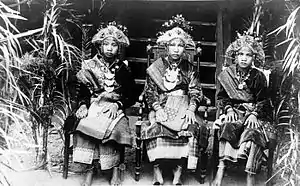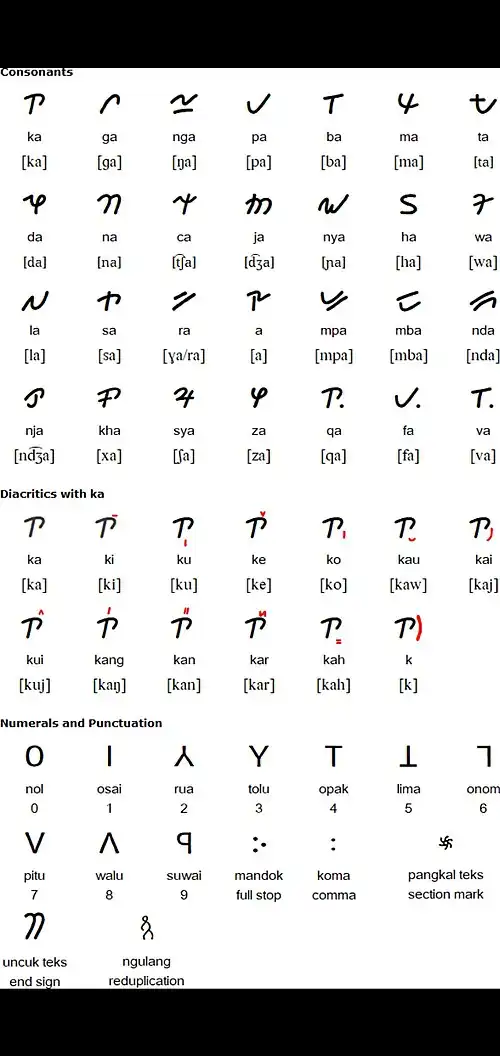| Komering | |
|---|---|
| Basa Kumoring باس كوموريڠ | |
| Pronunciation | [baˈsa ku.mo.ɣiŋ] |
| Native to | Indonesia |
| Region | South Sumatra
|
| Ethnicity | Komering |
Native speakers | 470,000 (2000 census)[1] |
| Lampung (historical, mainly for Komering Hulu dialect)
Latin (present and majority) Komering (present and minority, mainly for Komering Ilir dialect) Jawi (present and minority) | |
| Language codes | |
| ISO 639-3 | kge |
| Glottolog | kome1238 |

Komering is a Lampungic language spoken by the Komering people, an indigenous ethnic group native to Komering regions alongside the Komering River in South Sumatra, Indonesia.
Location
Komering is spoken in Lampung Province and South Sumatra Province in southern Sumatra, along the Komering River.
Classification
The Komering language belongs to the Lampungic branch, which is a subgroup within the Austronesian family.[2][3]
Phonology
Consonants
| Labial | Alveolar | Palatal | Velar | Glottal | ||
|---|---|---|---|---|---|---|
| Nasal | m | n | ɲ | ŋ | ||
| Plosive/ Affricate |
voiceless | p | t | tʃ | k | ʔ |
| voiced | b | d | dʒ | ɡ | ||
| Fricative | s | h | ||||
| Lateral | l | |||||
| Trill | r | |||||
| Approximant | w | j | ||||
A voiced fricative /z/ also occurs, but only as a result of foreign loanwords.
Vowels
| Front | Central | Back | |
|---|---|---|---|
| Close | i | u | |
| Mid | o | ||
| Open | a |
Vocabulary
Examples of basic Komering words:[4]
| Komering (standard) | Meaning |
|---|---|
| Kayu | Tree |
| Habu | Ashes |
| Tanoh | World |
| Jukuk | Grass |
| Hatolui | Egg |
| Tolu | Three |
| Hujan | Rain |
| Hambur | To Steal |
| Tohlui | Egg |
| Pak | Four |
| Ganta | Now |
| Ompai | New |
| Sisu | Chicken |
| Manuk | Bird |
| Bunga | Flower |
| Punti | Banana |
| Punti Kayu | Papaya |
| Halimawong | Tiger |
| Iwak | Fish |
| Turui | Sleep |
| Batangari | River |
Alphabet

Currently, Komering uses Latin as the general writing system, but there are also a small number of people who still use Jawi Arabic letters. The Komering script was only used in ancient times, now there are efforts to preserve this script again.
Sample Text
Universal Declaration of Human Rights 1
- Komering (Latin script)
Kaunyin jolma tilahirko mardeka rik uwat pi'il rik hak-hak sai goh-goh. Tiyan tiunjuk akal pikiran rik hati nurani mari tiyan dapok nyampur rik sai barihna dilom semangat bukolpah.
- Komering (Jawi script)
كأوݧين جولما تيلاحير كو مرديكا ريک اوت ڤيئيل ريک حق-حق سي گوه گوه. تيان تيئونجوک اكل ڤيكيرن ريک هاتي نوراني ماري تيان داڤوک ݧامڤور ريک سي باريه ن ديلوم سماڠت بوكولڤه.
Notes and references
Sources
- Adelaar, Alexander, The Austronesian Languages of Asia and Madagascar: A Historical Perspective, The Austronesian Languages of Asia and Madagascar, pp. 1–42, Routledge Language Family Series, Londres, Routledge, 2005, ISBN 0-7007-1286-0
- Walker, Dale F., A Lexical Study of Lampung Dialects, Miscellaneous Studies in Indonesian and Languages in Indonesia, Part I (editor: John W. M. Verhaar), NUSA Linguistic Studies in Indonesian and Languages of Indonesia, Volume 1, pp. 11–21, Jakarta, Badan Penyelenggara Seri NUSA, 1975.
- Walker, Dale F., A Grammar of the Lampung Language: the Pesisir Dialect of Way Lima, NUSA Linguistic Studies in Indonesian and Languages of Indonesia, Volume 2, Jakarta, Badan Penyelenggara Seri NUSA, 1976.
- Sofjan Abdurrahman, and Colin Yallop. A Brief Outline of Komering Phonology and Morphology, Miscellaneous studies in Indonesian and languages in Indonesia, Part VI (editor: Amran Halim), NUSA Linguistic Studies in Indonesian and Languages of Indonesia, Volume 7, pp. 11-18, Jakarta, Universitas Katolik Indonesia Atma Jaya, 1979.